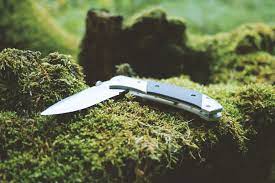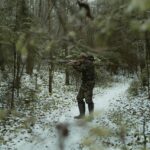Surviving in the wild is a test of both skill and preparedness, and the right tools are your lifeline in the great outdoors. Whether you’re an avid adventurer or just looking to boost your survival knowledge, this comprehensive guide will be your compass to essential bushcraft and survival tools.
In this article, we’ll embark on a journey through the wilderness, exploring the gear that can make all the difference in your survival. So, let’s walk into the world of survival gear and discover what it takes to thrive in nature’s playground.
The Inevitability of Essential Tools for Bushcraft
When it comes to bushcraft and survival, the importance of having the right tools cannot be overstated. These tools are not mere accessories; they are your lifeline in the wild. When you venture into the wilderness, you enter a world where self-reliance and resourcefulness are paramount. Nature is both your ally and your adversary, and to navigate it successfully, you must equip yourself with the essential tools that will aid your survival.
The tools you carry can mean the difference between a safe return and a perilous struggle. Get to understand why these tools are not just a luxury but an inevitability in the world of bushcraft and survival, and also how they empower you, provide security, and enhance your ability to conquer the wilderness.
Knife and Cutting Tools
Knives and cutting tools are the quintessential companions that can make the difference between thriving and merely surviving. Here are the compelling reasons why these tools are truly indispensable:
- Versatility: Knives and cutting tools are the Swiss Army knives of survival gear, serving a plethora of purposes. Their versatility knows no bounds.
- Resource Gathering: These tools empower you to gather and process resources efficiently. You can cut branches for firewood, carve traps and tools, and process game for sustenance.
- Self-reliance: Carrying a reliable knife fosters self-reliance and confidence in your ability to handle wilderness challenges. It’s your primary tool for crafting solutions to survival problems.
- Safety: A well-maintained knife enhances safety by providing a means to protect yourself from potential threats and predators.
- Precision: The sharpness and precision of a good knife are essential for tasks like dressing wounds, removing splinters, and intricate crafting.
- Durability: High-quality knives can withstand harsh conditions and extended use, ensuring they remain functional throughout your wilderness journey.
- Signalization: Reflective surfaces on some knife blades can be used for signalization, helping you attract attention in emergency situations.
- Food Preparation: Efficiently cutting and processing food ensures proper nutrition and minimizes the wastage of precious resources.
- Confidence and Comfort: Carrying a trusted knife provides a sense of security, comfort, and readiness to tackle unforeseen challenges in the wilderness.
- Spiritual and Psychological Benefits: Fire has been a source of inspiration and comfort for humans throughout history, offering a connection to nature and a focal point for meditation and reflection in the wilderness.
- Tool Sterilization: Properly sterilized knives can be used for wound dressing, surgical procedures, and the maintenance of other tools, preventing infections and illnesses.
- Cordage Crafting: A sharp knife can be used to process natural materials into cordage, ropes, and other essential survival items, expanding its utility even further.
Fixed Blade Knives
Fixed blade knives are sturdy and versatile, making them indispensable in survival situations. They come in various shapes and sizes, each with its unique advantages. When choosing a fixed blade knife, consider factors like blade material, handle design, and overall durability. Regular maintenance and sharpening are essential to keeping your fixed blade knife in top shape.
Folding Knives
Folding knives are compact and versatile cutting tools. They feature a hinged blade that can be folded into the handle, making them highly portable. These knives are prized for their convenience and are often chosen for everyday carry (EDC) due to their pocket-friendly size. They come in various styles, including slip joints, lockbacks, and liner locks, each offering different mechanisms for securing the blade in the open position. Folding knives are favored by outdoor enthusiasts, campers, and those looking for a reliable cutting tool that can easily fit in a pocket or backpack. They are known for their utility in various tasks, such as cutting rope, preparing food, and even self-defense when needed.
Fire-Making Tools
When venturing into the wilderness, the ability to create fire is not just a skill—it’s a necessity. Fire provides warmth, protection, and a means to cook food. Here are the reasons why fire-making tools are inevitable in your survival kit:
- Warmth and Comfort: Fire offers vital warmth in cold environments, helping you stave off hypothermia and ensuring a comfortable night’s rest.
- Cooking and Purifying Water: Fire allows you to cook and sterilize water, making it safe for consumption, thus preventing dehydration and foodborne illnesses.
- Protection: A well-tended fire can deter wildlife and serve as a signal for rescuers in case of emergencies.
- Psychological Boost: Fire provides a sense of security and comfort, boosting morale in challenging situations.
- Tool Sterilization: It’s essential for sterilizing tools and first aid instruments to prevent infection.
- Insect Repellent: Smoke from the fire can help keep pesky insects at bay, reducing the risk of bites and diseases.
- Signalization: A blazing fire can be seen from afar and serves as a signal for potential rescuers.
- Coping with Wet Conditions: Fire-making tools are invaluable when dealing with damp or wet conditions, as they can help dry out materials for ignition.
- Energy Source: In the absence of ready-to-eat food, fire allows you to cook and prepare meals, providing the energy needed for survival.
- Spiritual and Psychological Benefits: Fire has been a source of inspiration and comfort for humans throughout history, offering a connection to nature and a focal point for meditation and reflection in the wilderness.
Fire Starters
Fire starters are indispensable tools for igniting fires in the wilderness. They come in various forms, each designed to provide a reliable means of generating sparks or flames. Common types of fire starters include ferrocerium rods, firesteels, magnesium fire starters, flint and steel, and even electric lighters. These tools are crucial for initiating fires in various situations. Fire starters are compact, lightweight, and a staple in any survival kit.
Fire Tender
Fire tender is the material used to ignite and sustain a fire once a spark has been generated by a fire starter. It plays a critical role in fire-making by catching the initial spark and gradually building it into a flame. In the wild, you have two primary options for fire tender:
- Natural Fire Tender: This includes dry leaves, grass, twigs, bark, pine needles, and other readily available materials found in the wilderness. These natural materials ignite easily and are essential for starting fires in outdoor environments.
- Commercial Fire Tender: Commercially available fire tender products, such as fire starter sticks and cotton balls soaked in wax or char cloth, are designed to ignite quickly and burn steadily. They are particularly useful when dealing with challenging weather conditions or limited natural resources.
The choice of fire tender depends on your specific circumstances and the resources at your disposal. Regardless of the type you use, keeping your fire tender dry is crucial for successful fire-making, as a damp tinder can make ignition difficult or impossible. Mastery of gathering and preparing tinder materials is a valuable survival skill in the wilderness.
Shelter-Building Tools
In the wild, having shelter is not a luxury; it’s a fundamental requirement for survival. Shelter provides protection from the elements and offers a safe haven. Here are the reasons why shelter-building tools are essential in your survival kit:
- Protection from Harsh Weather: Shelter tools enable you to create a barrier against rain, snow, wind, and extreme temperatures, preventing exposure-related illnesses.
- Preservation of Body Heat: A well-constructed shelter helps retain body heat, preventing hypothermia and ensuring a comfortable night’s sleep.
- Privacy and Security: Shelters offer privacy and security, shielding you from potential threats and providing a sense of safety.
- Rest and Recovery: A shelter provides a place to rest and recover, conserving energy for other survival tasks.
- Storage: Shelter tools can help you store gear, food, and water, protecting them from the elements and potential scavengers.
- Psychological Comfort: Having a shelter creates a sense of normalcy and comfort in the wilderness, reducing stress and anxiety.
- Signalization: A well-constructed shelter can be a visible signal for search and rescue teams, guiding them to your location.
- Versatility: Shelter-building tools can be used creatively to adapt to different environments and terrains, ensuring your adaptability in various survival scenarios.
- Privacy and Dignity: In challenging situations, shelter offers privacy for personal hygiene and maintains your dignity in the wild.
- Community: Shelter can serve as a gathering point and foster a sense of community when surviving with others, enhancing your chances of mutual support and cooperation.
Tarps and Tarp Shelters
Tarps, short for “tarpaulins,” are versatile and indispensable tools in survival and bushcraft. These large, waterproof sheets of fabric are used to create improvised shelters known as tarp shelters. Tarps serve multiple purposes, including providing shelter from rain, wind, and sun, serving as ground cover for insulation and comfort, collecting rainwater for hydration, and protecting gear, food, and firewood from the elements.
Tarp shelters, on the other hand, are improvised structures created by suspending and securing a tarp in a way that offers protection and comfort. Common tarp shelter configurations include the A-Frame, Lean-To, Teepee or Pyramid, Diamond Fly, and Plow Point. Tarps and tarp shelters are quick to assemble, lightweight, and adaptable to various situations, making them invaluable tools for providing protection and comfort in the wild. They are a key component of any survival kit and are particularly useful when traditional tents or shelters are unavailable.
Paracord and Ropes
Paracord, short for “parachute cord,” and ropes are versatile and fundamental tools for survival and bushcraft. These strong and durable cords come in various lengths and thicknesses and serve multiple essential purposes in outdoor scenarios.
Paracord: Paracord is a lightweight and versatile cord originally used in parachutes. It consists of a strong nylon outer sheath and inner strands that can be extracted for additional uses. Paracord is indispensable due to its strength, versatility, and durability.
Ropes: Ropes, made from various materials like nylon, polyester, or natural fibers, are essential for a range of outdoor tasks, including shelter construction, climbing, watercraft, gear lashing, and emergency situations. They provide the strength and versatility needed to tackle a wide range of tasks in the wilderness, making them invaluable tools for survival and outdoor adventures.
Navigation Tools
Navigating the wilderness is a skill that can mean the difference between reaching safety and becoming lost in the vast expanse of nature. Here are the reasons why navigation tools are indispensable for your outdoor adventures:
- Directional Accuracy: Navigation tools, such as compasses and maps, provide precise directional information, helping you stay on course and avoid getting lost.
- Safety: Accurate navigation tools keep you away from hazards like cliffs, steep terrain, or dangerous wildlife, ensuring your safety during outdoor journeys.
- Efficiency: Proper navigation tools help you find the shortest and most efficient routes, conserving energy and resources.
- Orientation: They assist in identifying landmarks, ensuring you can retrace your steps if needed, and making it easier for rescuers to locate you.
- Confidence: Navigation tools boost your confidence and reduce anxiety, enabling you to explore and adventure with peace of mind.
- Route Planning: They aid in planning routes, estimating travel times, and selecting suitable campsites, which are critical for long journeys.
- Emergency Response: Accurate navigation tools facilitate a more precise response to emergencies, ensuring that you can quickly communicate your location to rescue teams.
- Backcountry Exploration: Navigation tools open up opportunities for backcountry exploration, allowing you to discover remote and untouched areas safely.
- Environmental Awareness: They encourage environmental awareness by helping you follow Leave No Trace principles and minimize your impact on natural habitats.
- Outdoor Enjoyment: Navigational skills and tools enhance your overall outdoor experience, allowing you to immerse yourself in the beauty and wonder of the wilderness without fear of becoming disoriented.
Compasses
Compasses are essential navigational tools used for determining direction in the wilderness. They consist of a magnetized needle that aligns with the Earth’s magnetic field, indicating the cardinal points. Compasses are invaluable for:
- Maintaining directional accuracy and preventing getting lost in unfamiliar terrain.
- Efficient route planning and choosing the best paths to conserve energy and resources.
- Providing confidence and security when exploring remote or challenging environments.
- Assisting with orientation by helping you identify landmarks and plot your position on a map.
- Supporting emergency response by signaling your location to potential rescuers.
- Promoting environmental awareness by facilitating responsible navigation and minimizing your impact on natural habitats.
- Enhancing your overall outdoor experience by allowing you to immerse yourself in the wilderness with confidence and peace of mind.
In situations where GPS signals may be unreliable or unavailable, a compass remains a dependable tool for ensuring successful navigation and safe exploration of the wilderness.
Maps and Navigation Apps
Maps and navigation apps are invaluable tools for wilderness exploration and outdoor adventures. They provide essential information, guidance, and situational awareness to enhance your journey:
Maps and navigation apps have become indispensable companions for modern outdoor enthusiasts. They offer a wealth of information and support, enhancing your safety, efficiency, and overall enjoyment during wilderness adventures.
Water Purification Tools
Access to clean and safe drinking water is a non-negotiable aspect of survival. In the wild, water purification tools are not optional; they are vital for your well-being. Here’s why these tools are essential in your survival kit:
- Prevention of Waterborne Illness: Water purification tools remove harmful microorganisms, bacteria, and parasites, reducing the risk of waterborne diseases like giardia and cholera.
- Hydration: Safe water is crucial for staying hydrated, maintaining bodily functions, and preventing dehydration, especially in arid environments.
- Versatility: These tools can purify water from various sources, including rivers, lakes, and streams, ensuring a consistent supply of potable water.
- Independence: Water purification tools grant you independence from potentially contaminated water sources, allowing you to venture deeper into the wilderness.
- Emergency Preparedness: They are essential for emergency preparedness, ensuring you have access to safe drinking water during natural disasters or unexpected survival situations.
- Peace of Mind: Knowing you can purify water alleviates concerns about water quality, reducing stress and anxiety in survival scenarios.
- Resource Conservation: Purification tools help conserve your limited water supply by making the most of available sources and minimizing waste.
- Community Health: In group survival situations, these tools contribute to the overall health and well-being of your team by ensuring everyone has access to clean water.
- Long-Term Survival: Safe drinking water is essential for prolonged survival, enabling you to sustain yourself until rescue or help arrives.
- Environmental Responsibility: When you purify water, you minimize your environmental impact by avoiding the need to carry large quantities of bottled water, contributing to the preservation of natural ecosystems.
Water Filters
Water filters are essential devices for purifying natural water sources in the wilderness. These tools are designed to eliminate harmful microorganisms, bacteria, and parasites from the water, ensuring it is safe for consumption. Water filters typically consist of a filtration mechanism that screens out impurities as water passes through. They offer a reliable means of obtaining clean and potable water from various sources, such as rivers, lakes, and streams. Their compact and portable design makes them a practical addition to any survival kit or backpack.
Water Purification Tablets
Water purification tablets are compact and lightweight tools used for treating water in the wilderness. These tablets contain chemical agents that, when dissolved in water, effectively kill or neutralize harmful microorganisms, bacteria, and viruses, making the water safe for drinking.
Typically, water purification tablets are easy to use. You add the recommended number of tablets to a specified amount of water and wait for a designated period, allowing the chemicals to work and purify the water. This method provides a convenient and reliable way to ensure the safety of your drinking water, especially when other purification methods or tools are unavailable or impractical.
Water purification tablets are particularly useful for backpackers, hikers, and adventurers seeking lightweight and portable solutions to water treatment. They are also valuable additions to emergency preparedness kits, providing a means of obtaining safe drinking water during natural disasters or survival scenarios where access to clean water sources may be limited or compromised.
First Aid and Medical Tools
Injuries and illnesses can occur suddenly and without warning. Carrying first aid and medical tools isn’t just a precaution—it’s a lifeline. Here’s why these tools are indispensable in your survival kit:
- Immediate Care: First aid tools allow you to provide immediate care for injuries, reducing the severity of wounds and increasing the chances of a swift recovery.
- Infection Prevention: Sterile materials and antiseptics help prevent infection, which is critical in the absence of medical facilities.
- Pain Management: Pain relief medications offer comfort and mobility, allowing you to continue essential survival tasks.
- Wound Dressing: Bandages, gauze, and tape are essential for wound dressing, preventing further contamination and promoting healing.
- Splinting: Injuries like fractures or sprains can immobilize you without splints or braces, making them crucial for mobility.
- Allergy and Medication Management: Allergy medication and prescribed medications are necessary to manage existing conditions and allergies, ensuring your health and well-being.
- Burn Treatment: Tools for treating burns are vital for injuries resulting from cooking, heating, or other fire-related incidents.
- Insect Bite and Sting Relief: Relief from insect bites and stings prevents allergic reactions and discomfort, allowing you to focus on survival tasks.
- Hydration: Oral rehydration salts help combat dehydration, particularly in hot or arid environments.
- Psychological Support: First aid tools offer psychological support by providing a sense of control and readiness, reducing anxiety in stressful situations.
- Community Health: In group survival situations, first aid and medical tools are essential for the overall health and well-being of your team, ensuring that everyone can contribute effectively.
- Emergency Signalization: Certain first aid tools, such as mirrors or reflective materials, can double as signaling devices, increasing your chances of being spotted by rescuers.
- Self-Sufficiency: Having these tools promotes self-sufficiency, allowing you to handle medical emergencies independently when professional medical help is not immediately available.
First Aid Kits
First aid kits are essential and comprehensive collections of medical supplies and equipment designed to provide immediate medical assistance in emergencies and minor injury situations. These kits play a vital role in ensuring the health and well-being of individuals in various outdoor and survival scenarios.
First aid kits typically include:
- Bandages and Dressings: Various types and sizes of bandages and dressings are available for covering wounds, cuts, and burns.
- Antiseptics: Disinfectants and antiseptic wipes to clean wounds and prevent infections.
- Tweezers and Scissors: Tools for removing splinters, cutting tape, or trimming dressings.
- Pain Relievers: Over-the-counter pain medications for managing pain and discomfort.
- Adhesive Tape: Medical tape for securing bandages and dressings in place.
- Gloves: Disposable gloves to maintain hygiene and prevent the spread of infections.
- CPR Mask: A CPR mask for performing cardiopulmonary resuscitation safely.
- Thermometer: A thermometer for monitoring body temperature.
- Rescue Blanket: A reflective emergency blanket for maintaining body heat.
- Gauze Pads and Swabs: Sterile gauze pads and swabs for wound cleaning and dressing.
- First Aid Manual: A guide or manual with instructions on basic first aid procedures.
First aid kits are available in various sizes and configurations. They are essential for addressing injuries and medical emergencies, providing immediate care to reduce the severity of wounds, prevent infections, and alleviate pain. First aid kits are a cornerstone of safety and preparedness in outdoor activities and survival situations, ensuring that individuals can respond effectively to unexpected medical needs.
Survival Medications
Survival medications are a critical component of any well-prepared survival kit or first aid supplies. These medications are specifically chosen to address common health issues and medical emergencies that may arise during outdoor adventures or in survival situations. Here are some key aspects of survival medications:
- Pain Relief: Over-the-counter pain relievers such as ibuprofen or acetaminophen can help alleviate pain from injuries or headaches.
- Antihistamines: Antihistamines like diphenhydramine can be used to manage allergic reactions, itching, or symptoms of allergies caused by insect stings or plant contact.
- Anti-Diarrheal Medications: Diarrhea can quickly lead to dehydration in survival situations. Anti-diarrheal medications can help control this issue.
- Antibiotics: In some survival scenarios, particularly those involving remote or extended stays in the wilderness, antibiotics may be included to treat infections. However, their use should be under the guidance of a medical professional.
- Anti-Inflammatories: Non-steroidal anti-inflammatory drugs (NSAIDs) like aspirin or naproxen can help reduce inflammation and pain associated with injuries or illnesses.
- Topical Ointments: Antibacterial or antiseptic ointments can be used to clean and protect wounds from infection.
- Oral Rehydration Salts: These salts help replenish electrolytes and fluids lost due to dehydration, a common concern in survival situations.
It’s important to note that survival medications should be used with caution and under appropriate circumstances. In many cases, it’s advisable to consult with a medical professional before using certain medications, especially antibiotics.
Survival medications should be kept in a waterproof container and checked regularly to ensure they remain within their expiration dates. While they can be valuable for addressing health issues in remote or emergency settings, they should complement, not replace, proper wilderness safety practices and first aid knowledge.
Food Procurement Tools
In a survival situation, procuring food is paramount to sustain your energy and stay alive. Food procurement tools are not just helpful; they are essential for securing nourishment. Here’s why these tools are indispensable in your survival kit:
- Sustenance: Food procurement tools enable you to source and secure food, providing the energy needed for survival and tasks like shelter-building and navigation.
- Independence: They grant you independence from pre-packaged food, allowing you to adapt to your environment and make the most of available resources.
- Protein and Nutrient Intake: Tools for fishing and trapping help you acquire protein-rich foods, maintaining your strength and health.
- Conservation of Resources: Procuring food from the wild enables you to conserve your limited food supplies, extending your survival duration.
- Environmental Adaptability: Food procurement tools can be used in various environments, enhancing your adaptability in diverse survival scenarios.
- Preparation and Cooking: These tools are essential for preparing and cooking food safely, reducing the risk of foodborne illnesses.
- Community Support: In group survival situations, food procurement tools contribute to the overall sustenance of your team, ensuring everyone has access to nourishment.
- Psychological Boost: Success in food procurement boosts morale and motivation, reinforcing your determination to survive.
- Diversity of Diet: Procuring food allows you to diversify your diet, minimizing monotony and enhancing overall nutrition.
- Environmental Awareness: These tools encourage you to understand the local flora and fauna, promoting environmental responsibility and reducing over-harvesting.
- Survival Skill Mastery: Proficiency in food procurement tools is a critical survival skill that can be honed over time, increasing your self-reliance in the wild.
- Coping with Extended Survival: In long-term survival situations, these tools become even more critical, as they provide a consistent source of sustenance until rescue or help arrives.
Fishing Gear
Fishing gear comprises tools and equipment for catching fish and aquatic creatures in the wilderness. It includes fishing rods, reels, lines, hooks, bait, tackle, nets, and essential tools like pliers and knives.
A fishing rod casts and reels in the line, paired with a reel to manage line length and tension. The line supports hooks and bait. Hooks vary in size and design, while bait can be live or artificial. Tackle accessories control bait depth and presentation.
Fishing gear also includes nets for handling fish, pliers for hook removal, knives for cleaning, and containers for carrying fish. Local fishing regulations may require a license.
Fishing gear is vital for obtaining food in the wild, provided you understand fishing techniques and fish behavior. Follow regulations and practice responsible catch-and-release when needed.
Traps and Snares
Traps and snares are essential tools for procuring food in a survival or wilderness setting. They are designed to capture animals for sustenance and can be invaluable in situations where other food sources are scarce. Here’s a closer look at traps and snares:
- Trap Types: There are various types of traps, including deadfall traps, pitfall traps, and cage traps, each designed for specific animals and situations.
- Snares: Snares are simple, noose-like devices placed in an animal’s path to catch and restrain it when triggered. They are typically made from strong cordage or wire.
- Bait: Many traps and snares are baited with food or lures to attract animals. Knowing an animal’s behavior and preferences is crucial for successful trapping.
- Location: Proper placement of traps and snares is essential. Knowledge of animal tracks, trails, and behavior can help increase your chances of success.
- Checking and Maintenance: Regularly checking and maintaining traps and snares is crucial to prevent injured or trapped animals from suffering unnecessarily and to ensure your food source remains fresh.
- Regulations: Be aware of local hunting and trapping regulations, as they may restrict or govern the use of traps and snares.
Traps and snares are valuable tools for obtaining food in survival situations, but they require skill, knowledge, and ethical considerations. Using them responsibly and ethically is essential to minimize the impact on wildlife and ecosystems.
Multi-Functional Tools
When it comes to surviving in the wilderness, efficiency and versatility are key. Multi-functional tools are not just convenient; they are indispensable for simplifying tasks and saving valuable space in your survival kit. Here’s why these tools are essential:
- Space Efficiency: Multi-functional tools consolidate multiple tools into one, saving space and reducing the weight of your kit.
- Versatility: They offer a wide range of functions, such as cutting, sawing, opening cans, and more, making them adaptable to various survival tasks.
- Weight Reduction: Carrying one multi-tool is more weight-efficient than carrying multiple individual tools, allowing you to carry other essentials.
- Resourcefulness: These tools foster resourcefulness by providing creative solutions to unforeseen survival challenges.
- Convenience: Multi-functional tools provide easy access to essential functions without the need to rummage through your kit for specific tools.
- Time Savings: They save valuable time during survival tasks, allowing you to respond quickly to changing circumstances.
- Maintenance and Repairs: Multi-functional tools often include features for maintenance and repairs, helping you keep your gear in working order.
- Durability: High-quality multi-tools are designed to withstand rugged conditions and heavy use, ensuring long-term reliability.
- Self-Reliance: Having a multi-functional tool enhances your self-reliance by providing you with the means to tackle a wide range of survival challenges.
- Adaptability: These tools can adapt to different environments and scenarios, making them invaluable for diverse wilderness adventures.
- Emergency Situations: In emergency situations, multi-functional tools can be a lifesaver by providing immediate access to crucial functions like cutting, opening, or signaling.
- Community Support: In group survival scenarios, multi-functional tools can be shared among team members, enhancing the overall capabilities of the group.
- Backup: They serve as excellent backups to dedicated tools, ensuring you have redundancy in case of tool failure or loss.
Survival Multi-Tools
Survival multi-tools are compact and versatile devices that combine various functions into a single, portable unit. They often include features like knives, pliers, screwdrivers, can openers, and saws, providing valuable tools for a range of outdoor and survival tasks. Their compact design makes them easy to carry, making them convenient companions for camping, hiking, and emergency preparedness. While they offer versatility, it’s important to choose a high-quality model known for durability and reliability, ensuring that it can handle the challenges of outdoor use effectively.
These multi-tools can be a valuable addition to your outdoor gear, offering essential functions in a compact package. However, it’s important to understand their limitations and recognize that they may not replace specialized tools for specific tasks.
Duct Tape
Duct tape is a versatile and invaluable tool in outdoor and survival situations. Known for its durability and adhesive strength, it serves a multitude of purposes. In the wild, duct tape can mend torn clothing, seal leaks in equipment, reinforce shelter seams, and even help with medical treatments.
It’s a valuable asset for customizing gear, enhancing shelter construction, and improvising solutions to unexpected challenges. Additionally, duct tape can be used for trail marking, fire-starting, and emergency vehicle repairs. Its adaptability and compactness make it a vital tool for quick fixes and creative problem-solving in the wilderness.
Conclusion
Having the right tools can mean the difference between life and death in the bushcraft ecosystem. Whether it’s knives and fire-starting gear or shelter-building tools and navigation aids, each tool outlined in this guide plays a crucial role in your ability to thrive in the great outdoors. Knowledge and practice are equally important, so equip yourself with these essential tools and skills to be prepared for any situation that nature throws your way.







